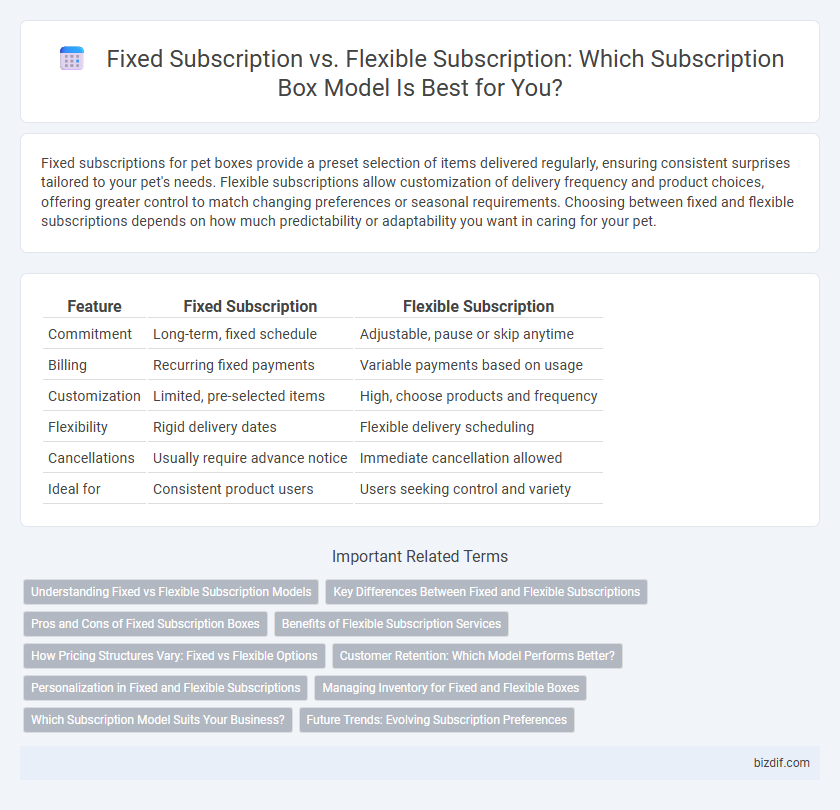Fixed subscriptions for pet boxes provide a preset selection of items delivered regularly, ensuring consistent surprises tailored to your pet's needs. Flexible subscriptions allow customization of delivery frequency and product choices, offering greater control to match changing preferences or seasonal requirements. Choosing between fixed and flexible subscriptions depends on how much predictability or adaptability you want in caring for your pet.
Table of Comparison
| Feature | Fixed Subscription | Flexible Subscription |
|---|---|---|
| Commitment | Long-term, fixed schedule | Adjustable, pause or skip anytime |
| Billing | Recurring fixed payments | Variable payments based on usage |
| Customization | Limited, pre-selected items | High, choose products and frequency |
| Flexibility | Rigid delivery dates | Flexible delivery scheduling |
| Cancellations | Usually require advance notice | Immediate cancellation allowed |
| Ideal for | Consistent product users | Users seeking control and variety |
Understanding Fixed vs Flexible Subscription Models
Fixed subscription models offer customers a predetermined selection of products delivered at regular intervals, ensuring consistency and predictability in each box's contents. Flexible subscription models allow subscribers to customize their orders by choosing items, frequency, or skipping shipments, providing a personalized experience tailored to individual preferences. Businesses benefit from fixed subscriptions by stabilizing inventory management, while flexible subscriptions enhance customer satisfaction through adaptability and control.
Key Differences Between Fixed and Flexible Subscriptions
Fixed subscriptions provide customers with a predetermined set of products delivered at regular intervals, ensuring consistency and predictability in their subscription box experience. Flexible subscriptions allow subscribers to customize delivery frequency, product selection, and pause or skip shipments, offering greater control and adaptability to changing preferences. Key differences include commitment level, customization options, and billing cycles, with fixed subscriptions emphasizing routine while flexible subscriptions prioritize personalization.
Pros and Cons of Fixed Subscription Boxes
Fixed subscription boxes offer consistent delivery of curated products, ensuring subscribers receive a predictable and themed experience tailored to their preferences. The main advantage is convenience, as users do not need to make choices each cycle, but the lack of flexibility can lead to dissatisfaction if items do not match changing tastes or needs. Fixed subscriptions suit those who enjoy discovering new products regularly without customization, though they may feel restrictive for customers who prefer more control over their selections.
Benefits of Flexible Subscription Services
Flexible subscription services offer personalized choices and adjustable delivery schedules, enhancing customer convenience and satisfaction. Subscribers can easily modify, skip, or cancel shipments, reducing commitment anxiety and increasing retention rates. This adaptability caters to diverse consumer needs and preferences, driving higher engagement and long-term loyalty.
How Pricing Structures Vary: Fixed vs Flexible Options
Fixed subscription pricing features a set monthly fee that covers a predetermined set of products or services, providing predictable costs and consistent value for customers. Flexible subscription pricing allows users to adjust their plan based on usage or preferences, often resulting in variable monthly charges tailored to individual needs. This pricing structure appeals to consumers seeking customization and budget control, contrasting with the straightforward, stable cost model of fixed subscriptions.
Customer Retention: Which Model Performs Better?
Fixed subscription models offer consistent delivery schedules and curated products, fostering routine and predictability that enhance customer retention rates through steady engagement. Flexible subscription models provide customization and control, catering to changing consumer preferences and reducing churn by allowing pauses, skips, or product swaps. Studies indicate flexible subscriptions generally outperform fixed plans in retaining customers by aligning with evolving needs and increasing satisfaction.
Personalization in Fixed and Flexible Subscriptions
Fixed subscriptions offer limited personalization, typically providing a curated selection of items based on general preferences, ensuring consistency and predictability in each delivery. Flexible subscriptions allow subscribers to tailor their boxes with specific product choices or frequency adjustments, enhancing the customization experience to better meet individual needs. Emphasizing personalization, flexible subscriptions adapt dynamically to subscriber feedback and trends, delivering increased satisfaction and engagement.
Managing Inventory for Fixed and Flexible Boxes
Fixed subscription boxes require precise inventory management due to their consistent product lineup, necessitating accurate demand forecasting to avoid overstock or shortages. Flexible subscription boxes demand a dynamic inventory system that can adapt to varying customer choices and fluctuating order quantities, enhancing customization but increasing complexity. Effective inventory management software with real-time tracking supports both models by optimizing stock levels and reducing waste.
Which Subscription Model Suits Your Business?
Fixed subscription models provide consistent revenue with predetermined products delivered regularly, ideal for businesses with stable inventory and predictable customer preferences. Flexible subscriptions offer customization options and varied delivery schedules, catering to businesses focused on personalization and customer retention. Choosing the right subscription model depends on your business goals, product type, and customer behavior insights to maximize engagement and profitability.
Future Trends: Evolving Subscription Preferences
Fixed subscriptions offer consistent product deliveries and predictable billing, appealing to consumers seeking routine and stability. Flexible subscriptions provide customizable options and adjustable delivery frequencies, meeting the growing demand for personalization and convenience. Future trends indicate a shift towards hybrid models that balance fixed benefits with flexible features, driven by advancements in AI and data analytics enhancing consumer experience.
Fixed Subscription vs Flexible Subscription Infographic

 bizdif.com
bizdif.com